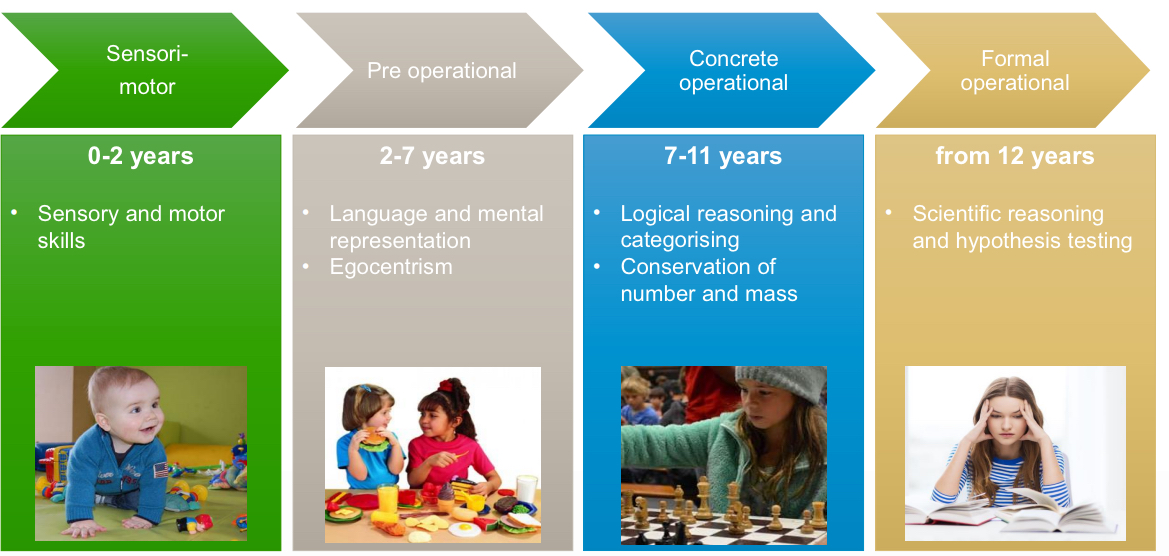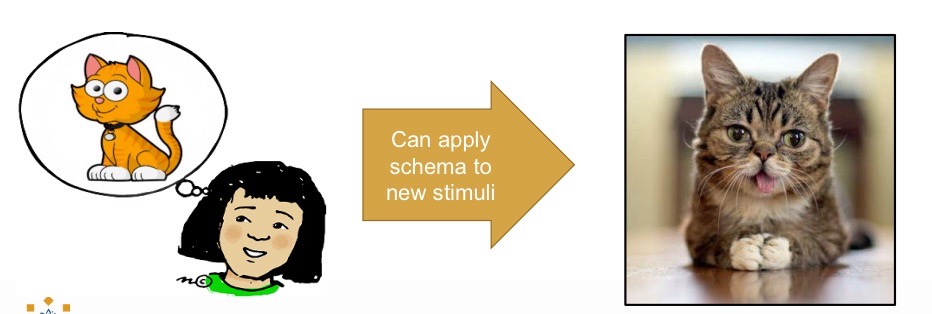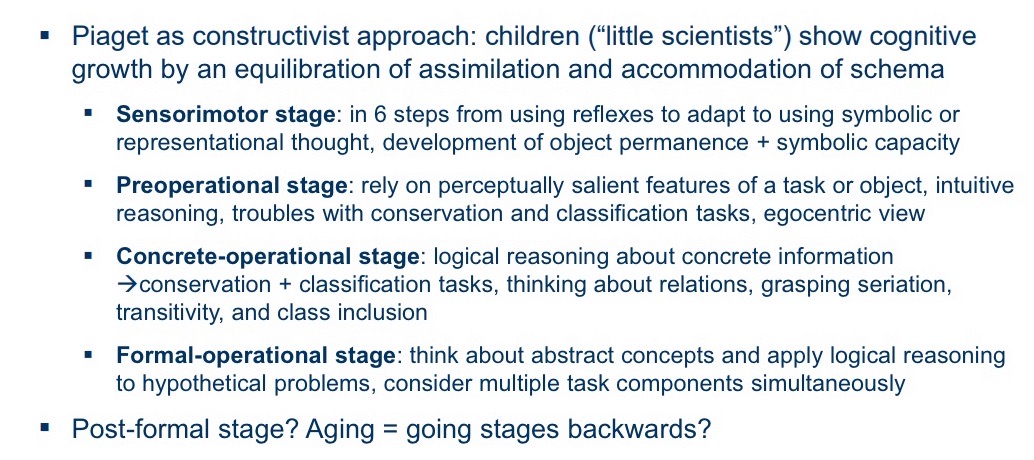developmental psychology ch4
1/47
Earn XP
Description and Tags
Name | Mastery | Learn | Test | Matching | Spaced |
|---|
No study sessions yet.
48 Terms
Jean Piaget (1896-1980):
Pioneer in the domain of cognitive development of children.
How does cognition develop according to Piaget?
Universally fixed order of phases → discontinuous development → Each phase qualitatively different → child actively contributes to own knowledge formation
Piaget’s stages od development:

Schema:
Building blocks of knowledge (piece of knowledge)
Assimilation:
Existing schema is used in new situation.

Accomodation:
When the existing schema doesn’t work, it need to be changed to deal with a new situation.
Equilibration:
Balance between assimilation and accommodation.
What happens in the sensori-motor phase?
Learning about the world via senses, development of motor skills.
No theory of mind
Circular responses
Object permamence
Theory of minds in children in sensorimotor phase:
Children in the sensorimotor phase cannot imagine the intentions, emotions, and expectations of others.
Circular responses:
Circular reactions are both:
Repetitive responses — the child repeats an action that initially happened by chance
And they drive development — through that repetition, the child learns, refines skills, and builds cognitive understanding.
Circular responses in the sensorimotor phase:
S1. Reflexes (Birth – 1 month): Newborn reflexive responses to stimuli.
S2. Primary Circular Responses (1 – 4 months): Simple motor habits centered on own body.
S3. Secondary Circular Responses (4 – 8 months): Repeats actions to observe effects in environment.
S4. Coordinating Secondary Circular Responses (8 – 12 months): Intentional, goal-oriented behavior; begins object permanence.
S5. Tertiary Circular Responses (12 – 18 months): Experiments with new actions on objects – “little scientist” phase.
S6. Mental Representations (18 months – 2 years): Internal representation of objects/events; delayed imitation emerges.
S1. Reflexes (Birth – 1 month)
Reflexes of the newborn – automatic responses to stimuli.
S2. Primary Circular Responses (1 – 4 months)
Simple motor habits centered on the infant’s own body.
S3. Secondary Circular Responses (4 – 8 months
Repeating actions to observe interesting effects in the environment.
S4. Coordinating Secondary Circular Responses (8 – 12 months)
Intentional, goal-directed behavior; development of object permanence.
S5. Tertiary Circular Responses (12 – 18 months)
Exploring properties of objects with new actions – the “little scientist” phase.
S6. Mental Representations (18 months – 2 years)
Internal representation of objects/events; ability for delayed imitation.
Delayed imitation = the ability to observe a behaviour and reproduce it after a time delay, connected to storing mental representations.
Object permamence:
Understanding that something still exists when it is out of sight.
Around 9 months first signs of object permanence
Tested by A not B error test: A kid is shown a toy, toy is hidden under a blanket and the kid retrieves it, but when two blankets are present it doesn’t know when the toy went.
Around 1 year: better object permamence
Piaget explains A not B error as immature object permamence
But memory, inhibition, planning, and positive reinforcement may also play a role.
Critique of Piaget’s theory:
Underestimated abilities of infants
Infants grasp the basics of physical reality well before age well before 1 age (Piaget lacked methods)
Understanding of physical reality develops gradually, not in huge qualitative stages
They already show basic insight in emotions and intentions of others
→ Now rather information processing approach: thinking is divided into specific steps and processes, like a computer
Research: cognition of babies
Baby < 1 year: basic understanding of laws of nature (gravity, volume, continuity of movement)
Violation of expected physics rules: → Looking longer after unexpected outcome
What happens in the pre-operational phase? 2-7 years
Language and mental representations
Symbolic capacity
Intuitive reasoning
Magical thinking
No understanding of conservation
Egocentric perspective
Language in the pre-operational phase:
The young child learns to use symbols and language → product of cognitive development.
Symbolic capacity emerged at the end of sensorimotor stage → advancements of preschoolers.
Use of words to refer to things, people, and events that are not physically present also past/future.
Pretend or fantasy play flourished: chair can stand for a train, role play.
Intuitive reasoning:
Preschoolers use of primitive reasoning to acquire knowledge.
Curiosity blossoms: Why questions become central
At the same time: Explanation of the world with own logic, their intuitive thought leads them to confidently believe they know answers to all kids of questions.
Examples:
Feeling of participation
Animism
Articialism
Finalism
Transductive reasoning
Feeling of participation:
Child participates dynamically in the actions of nature, accompanied by beliefs in magic
Animism:
Things are conscious and alive.
Artificialism:
Everything is willed, intentional and organised for the good of man.
Finalism:
Everything has an explanation.
Transductive reasoning:
Combining unrelated facts leading to draw faulty cause-effect conclusions simply because two events occur close together in time or space.
Ex. Clouds move because they feel cold
Magical thinking:
Consequence of animism: to be afraid in the dark and imagining monsters.
Phase in which children have nightmares, difficult to calm down.
Sensitive to fantasies → in both positive and negative ways
Consequence: Imaginary companion → 28% of the 3 and 4 year olds report to play with an imaginary friend, lasts into school years.
Positive consequences: Advanced cognitive and social development, higher levels of creativity and imaginary use. More engagement in private speech.
Lack of conservation: Conservation test
Understanding that certain properties remain identical despite changes in appearance.
Children in this phase (3-4 years) don’t get it.

Why do children in this phase not understand conservation?
Centering: attention goes to visually most salient parts → single aspect of a problem
Irreversibility: not able to mentally reverse change
Static thought: Thought is fixed on end states rather than the changes that transform one state into another.
No understanding of identity constancy: people remain their essential self despite changes in their appearance
Egocentric perspective:
Child views the world from an egocentric perspective = the inability to understand that other people have different point of view, they don’t realise what is in their mind isn’t in everyone else’s - visually and mentally.
Classic Test: Three mountains test
Kids receive 10 pictures with different views - What does the doll see?
Piaget and Inhelder:
4 year old → own perspective
7 year old → correct other perspective
Criticism: Too complex, unrelated test
What happens in the concrete operational phase? 7-11 years
Logical reasoning, but not scientific
Categorisation
Conservation of number and mass
Seriation
Transitivity

Classification: Are there more dogs or more animals in this picture?
Pre operational phase: Dogs
Concrete operational phase: Animals
→ Understanding of class inclusion: logical understanding that parts are included in the whole
Seriation:
The ability to arrange objects based on features (ex. shortest - longest)
Transitivity:
Ability to logically combine relations to reach certain conclusions
→ Reasoning about the relations between elements in a series
Transitivity Task:

Differences in childhood phases:
Early childhood - ages 3 to 6 (preschool and kindergarten)
Entering the world of play
Developing language
Tethered to their immediate perceptions
Curiosity, try to explain the world
Middle childhood: ages 7-11/12 (elementary school)
Inductive reasoning → Logic closer to the one of adults
Less egocentric view of the world
Due to advancements in inductive reasoning: developments in strategy usage, resulting in better memory
Pre-operational vs Concrete-Operational Thinkers:
Preoperational Thinkers (Ages 2–7):
Irreversible thought: Can’t mentally undo actions
Centration: Focus on one aspect
Static thought: Don’t grasp transformation
Perceptual salience: Judgments based on appearance
Transductive reasoning: Link unrelated events
Egocentrism: Struggle with others’ perspectives
Single classification: Sort by one dimension only
Concrete-Operational Thinkers (Ages 7–11):
Reversibility of thought: Can undo actions mentally
Decentration: Focus on multiple aspects
Transformational thought: Understand changes
Logical reasoning: Use internal operations
Inductive reasoning: Draw logical conclusions
Less egocentrism: Understand others’ thoughts
Multiple classification: Categorize by multiple dimensions
What happens in the formal operational phase? From 12 yrs old
Scientific reasoning and hypothesis testing - systematically exploring possibilities.
Abstract thinking.
Classical task: Third eye task
“If you could have a third eye and put it anywhere on your body where would u put it any why?”
Adolescent Egocentrism: hightened self-consciousness, imagining audience, personal fable
Some adults never become formal operational thinkers…
Early and late formal operations:
Younger adolescents: Simple hypothetical propositions, struggle solving a problem or systematically generate and test hypotheses.
Older adolescents: Still only 50-60% of tasks testing scientific reasoning correctly solved, bias: evidence consistent with pre-existing beliefs rather than evidence inconsistent.
Formal operations: Relevance for transition to adulthood
Behaving like adults: Approach problems in a systematic way and have independent control of complex situations
Highschool curricula adapted to new skill: Understand a poetic metaphor, understand chemistry experiment, debate
Thinking about identity, planning for future, better understanding of other people, better appreciation of humor
Questioning → confusion and rebellion against whatever seems illogical → idealistic thinking, perfect worlds
Formal operations fully achieved in adulthood?
Only 50% of all American college students master Piaget’s scientific reasoning tasks → also show better grades.
Cultural differences.
Solving formal tasks linked to intelligence and formal educations.
Difference between areas of expertise.
What happens in adulthood?
Post-formal thought: suggested as a stage after formal operational phase - more complex way of thinking.
Understanding that knowledge is relative, not absolute - many grey areas.
Accepting that the world is filled with contradictions.
Attempting to integrate the contradictions into some large understanding.
Post-formal though shows up as:
Relativistic thinking: conclusions depend on context and perspective, multiple solutions - many people start like this and then make commitment to positions.
Dialectic thinking: detecting paradoxes and inconsistencies among ideas and trying to reconcile them.
Foster by diverse environments, adult thought may indeed be different than formal thought, but it isn’t officially recognised as a stage.
Aging and Piaget’s tests:
Older adults often have trouble solving Piagetian tests of formal operational thinking.
Do adults go backwards in the stages?
Many studies cross-sectional: Less formal education in elderly
Relevance of skills: unfamiliar problems, more linked to tasks at school not everyday motivation?
Age related decline not firmly established.
Criticism of Piaget’s theory
Restricted research method
Underestimated children’s skills
Language as product of cognitive development (not cause)
Underestimated influence of social environment: Nature - nurture interaction.
Summary of the stages
